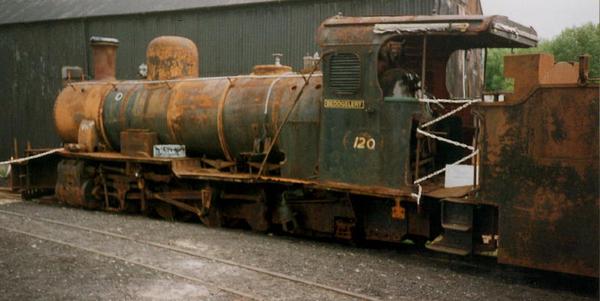- SAR NG15 Class
Infobox Locomotive
name = SAR NG 15
powertype = steam
builder =Henschel & Sohn ,Societe Anglo-Franco-Belge
builddate = 1931 - 1957
whytetype = 2-8-2
caption = NGG15 class locomotive Beddgelert awaiting restoration at the Welsh Highland Railway
driversize = 34 in (0.864m)
length = 54 ft 4 in (16.56 m)
axleload = 6.7 tons
weight = 36.6 tons (loco) plus 31.2 tons (tender)
tenderc
boilerpressure = 171 psi (1.18 MPa
totalsurface = 1028 ft² (95.5 m²)
cylindercount = 2
cylindersize = 15¾" x 17¾" (400mm x 450mm)
tractiveeffort = 18,820lbf (83.7 kN) - at 85% boiler pressureThe NG15 class of locomotives (sometimes called "Kalaharis") were a development of the HD class of
2-8-2 locomotives of theOtavi Mining and Railway Company inGerman South West Africa . Three HD class locomotives, built by Henschel & Sohn, were supplied on lease to the Otavi Railway Company by the German government in 1912. These locomotives had piston valves. At 59 tons, these locomotives were considerably larger than earlier main line Otavi Railway locomotives, which were typically less than 23 tons in full working order.Six similar locomotives from Henschel & Sohn were placed in service during 1922, being classified NG5 by SAR who were responsible for operating railways in SWA (South West Africa) at this time. These locomotives had slide valves.
One of the NG5 locomotives was sent east to the Avontuur line for trials, but it jammed on the tighter curves. This was despite having one pair of flangeless driving wheels. The locomotive was returned to SWA.
The drawing board work for the NG15s has been attributed to the one time Chief Mechanical Engineer of the Otavi Railway, a German engineer called Mr. Peters, pronounced as Pay-tarz(?).
Mr Peters was employed as a draughtsman by SAR. The usual practice of the SAR at this time was to design locomotives in their own drawing offices and to then go out and find a builder.
All five batches of NG15 locomotives were built for service on the 600 mm. gauge Otavi Railway. The 30 2-8-2 locomotives operated in a common pool until the narrow gauge Otavi Railway was replaced beginning on
24 November 1960 by a new railway built to the Cape standard gaugeof 42 inches (1067 mm). At this time all 21 NG15 locomotives were transferred to the Eastern Cape for further service on the two foot (610 mm) gaugePort Elizabeth to Avontuur line. The six 1922 built NG5 locomotives were sold to a scrapdealer in 1962.Since the earlier trials with the NG5 locomotive the sharper curves of the Avontuur line had been eased. The leading pair of driving wheels of the NG15 also have a limited amount of sideplay and are linked to the leading pony truck. The axle of the leading driving wheels remains parallel to the other three driving axles at all times.
This linking of a pony truck and driving axle is known as a
Krauss-Helmholtz bogie , an invention ofRichard von Helmholtz who was chief designer at theKrauss works in Munich from 1884 to 1917. The inclusion of a Krauss-Helmholtz bogie has allowed the use of large 2-10-0 locomotives on sharply curved mountainsections of standard gauge railways in Europe. Some early electric locomotives also used Krauss-Helmholtz bogies.When first introduced onto the Avontuur line, the NG15s were not allowed to work beyond Humansdorp to Avontuur because of a lack of turning facilities on this section. This was rectified by the construction of a triangle at Avontuur.
References
* "Namib Narrow Gauge", by S.M.Moir and H.Temple Crittenden. The Oakwood Press.
* "24 Inches Apart", by Sidney Moir. Janus Publishing, 1981.
* "The Locomotive in South Africa", by T.J.Espitalier and W.A.J.Day. South African Transport Services Museum, 1989.
* "The Kei Explorer 1989", South African Transport Services Museum and Railway Society of S.A.
* "The Steam Locomotive, A History", by David Ross. Tempus Publishing Limited, 2006.
* [http://www.whr.co.uk/s/stock/ng15 WHR Porthmadog NG15 Class]
* [http://www.sarsteam.co.za/steam_specs_2ft0in_tender.php?locoid=5 SAR Steam 2ft 0in SAR Class NG15 Tender]
Wikimedia Foundation. 2010.

_water)